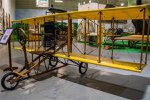The museum features a 75-seat theater, large open area for special events and a gift shop. In addition to seeing the museum displays and exhibits, visitors are welcome to visit the Restoration Shop, talk with volunteer craftsman and watch them work on historic aircraft.
Glenn Curtiss began his career as a builder of bicycles and then, motorcycles. In 1907 he became the “fastest man on earth” when he attained a speed of 136.4 MPH on his V8 powered motorcycle. An exact reproduction of this bike is one of several Curtiss motorcycles that are on display.
On July 4th, 1908, Curtiss gained notoriety of a different kind when he flew his flying machine, named the “June Bug”, a distance of over 5000 feet to win the Scientific American Trophy. This was the first pre-announced, public flight in America – a feat that earned him pilot’s license # 1. A full-sized reproduction of the “June Bug” is one of several historic aircraft on display.Glenn Curtiss won world recognition as an aircraft builder and pilot in 1909 when he won the Gordon Bennett Trophy for speed at the First International Aviation Meet held in Reims, France. During this flight he achieved the breath-taking speed of 46.5 MPH (he went 90 MPH faster on a motorcycle two years earlier).
Back in the states, a year later, Curtiss again furthered his eminence as a pioneer aviator by making the first long distance flight in America, between two cities. He flew from Albany to New York City with one stop, for a total distance of 150 miles to win a $10,000 prize and the Scientific American Trophy (again). In 1911 he mastered the technology associated with taking off and landing an aircraft on water, thereby making the “seaplane” and later, the “flying boat”, a practical reality. Seaplane development led Curtiss to an association with the U.S. Navy that began when he trained their first pilots and built the “A-1”, their first aircraft. Today, he is acknowledged as “The Father of Naval Aviation”. Visitors to the museum will also see a full-scale reproduction of this first naval aircraft. Additional Curtiss aircraft in the collection include a 1912 “Pusher”, a 1913 “Model E” flying boat, a 1917 “Jenny”, a 1919 “Seagull” flying boat, and a 1927 “Robin”. From the Curtiss-Wright era (post 1929), included are a 1931 “Junior”, a ¾ scale P-40 and last – but certainly not least, a C-46, WWII transport (this aircraft will actually be seen first, because it guards the main gate). In addition to motorcycles and aircraft, visitors will also see antique tools, toys, boats, home-furnishings, fire equipment and much more. There’s something here for everyone!
Admission:
Adults Seniors (65 and over)Students (7-18)Children (6 & under)$10.00 $8.00$7.00Free
Members Free
Family Rate Adult Group Rate* Student Group Rate*$30.00 $7.00 each $3.00 each
* Groups consist of 10 or more people







